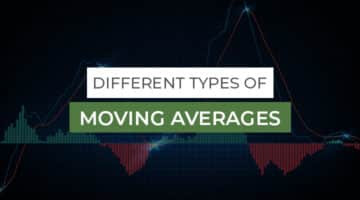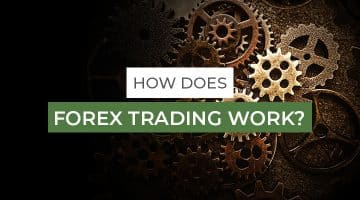Which are the Best Forex Indicators to Use?

In this article
If you are new to forex trading, technical analysis can be like solving a complex algebraic equation.
There are thousands of different technical indicators to put on your charts, and when trading the forex markets, choosing the right indicator can make or break your trading strategy.
In this guide, we’ll talk about what are some of the best technical indicators you can utilize.
What makes a good indicator?
Technical forex indicators are not all effective among traders. Some are only used in specific situations, others are used by derivatives traders, and a few can be seen on the screens of most technical traders.
A great forex indicator, in general, has wide applicability to many traders, gives straightforward signals that can be easily observed and traded on, and provides valuable information important to those looking to assess the future direction of currency movements.
Best forex indicators
Here are some of the best forex indicators:
1. Moving Averages
A moving average is one of the best forex indicators for any strategy. Moving averages help traders find trading opportunities in the direction of the overall trend.
When the market is rising, you can use the moving average or multiple moving averages to determine the trend and the best time to buy or sell.
The moving average is a plotted line that essentially calculates the average price of a currency pair over a given time period, such as the last 200 days, to understand the overall trend.
There are four types of moving averages:
- Simple moving averages (SMA)
- Exponential moving averages (EMA)
- Weighted moving averages (WMA)
- Smoothed moving averages (SMMA)
From these MAs, SMA and EMA are most common among traders.
Using moving averages to identify trading opportunities helps you see and trade momentum by entering as the forex pair moves in the direction of the moving average and exiting the trade when it starts to pivot in the opposite direction.
2. RSI (Relative Strength Index)
The RSI calculates the strength of recent price fluctuations. The RSI is calculated by taking the average profit and loss over a 14-day period. Its value ranges from 0 to 100, indicating overbought and oversold conditions.
If the price value is greater than 70, the market is overbought, and traders should be prepared for a price reversal. If the level is less than 30, it indicates an oversold condition, and the price will rise in the future.
50 is regarded as a neutral stage, and you must wait for the price to fall or rise before entering positions.
The RSI can be used in trending or ranging markets to locate entry and exit points. When markets have no clear direction, you can take either buy or sell position using the RSI.
3. MACD (Moving Average Convergence Divergence)
By combining two moving averages, the MACD defines price movements.
The MACD contains two moving averages: the 26-day EMA (exponential moving average) and the 12-day EMA (exponential moving average). It calculates by subtracting the 26-day EMA from the 12-day EMA. A 9-day EMA serves as a signal line.
A buy signal is produced when the 12-day EMA crosses above the 9-day EMA. When the 12-day EMA crosses below the 9-day EMA, this is a sell signal.
The best thing about MACD is that it can be used in trending or ranging markets because it employs moving averages, representing shifts in momentum.
4. Stochastic Oscillator
The Stochastic oscillator compares an asset’s closing price to historical values over a given time period.
Stochastic, like the RSI, produces overbought and oversold trading signals ranging from 0 to 100. Values greater than 80 are overbought, whereas values less than 20 are undersold. While the RSI only shows one line, the Stochastics shows two: a signal line and a trend line.
The indicator also tells traders about stock accumulation and distribution. When the market closes above the stochastic high prices, it indicates that there is buying pressure and the market is accumulating. On the other hand, the market closes near the indicator’s low value indicating selling pressure, and the market is in distribution.
5. Fibonacci Retracement
The Fibonacci retracement is a horizontal line indicator that indicates levels of support and resistance. The indicator is based on the Fibonacci sequence of numbers. Fib numbers are made up of a series of numbers that are formed by adding the previous two numbers, such as 0, 1, 1, 2, 3, 5, 8, 13, 21, and so on.
The calculations in the Fibonacci retracement indicator are done as a ratio. 23.6 percent, 38.2 percent, 50 percent, 61.8 percent, and 78.6 percent are the most common ratios.
You can use the indicator to draw a line between any two points, such as high and low. Between these two points, the Fibonacci retracement will establish support and resistance levels.
One of the pros of using Fibonacci retracement is that it can find exact entry and exit points, with stop-losses near the recent swing low or high.
6. Bollinger Bands
John Bollinger developed Bollinger Bands in the 1980s to provide trading signals that respond to market conditions. They are usually drawn with a predetermined number of standard deviations from a central moving average.
Drawing lines two standard deviations around a 20-period simple moving average is a standard set of parameters for Bollinger Bands. Since standard deviations are used to evaluate market volatility, this provides traders with a sense of the risk involved in taking positions.
When using Bollinger Bands, a common strategy is to detect overbought or oversold market conditions. When the price of an asset falls below the lower band of the Bollinger Bands, it indicates that prices have dropped too far and are about to recover. If the price breaks above the upper band, the market is likely overbought and waiting for a pullback.
Bottom line
Indicators can help you determine the trend’s strength or weakness. As no indicator is 100 percent accurate, you need to combine these indicators with other technical analysis forms to maximize trading potential.
Jason Morgan is an experienced forex analyst and writer with a deep understanding of the financial markets. With over 13+ years of industry experience, he has honed his skills in analyzing and forecasting currency movements, providing valuable insights to traders and investors.
Forex Content Writer | Market Analyst
Relevant Posts

What Time Does the Forex Market Open in South Africa?
[top_three_brokers] There are four major Forex centres worldwide: New York, London, Tokyo, and Sydney. Because…
Read more

Forex Tick Volume Explained
[top_three_brokers] Forex trading is all about volume. Financial institutions, banks, retail traders all make the…
Read more

Different Types of Moving Averages
[top_three_brokers] Moving averages can be defined to smooth out price fluctuations to help you distinguish between typical market…
Read more

What is Leverage in Forex?
Have you opened a new trading account and want to understand Leverage in Foreign exchange?…
Read more

What is Margin in Forex?
[top_three_brokers] What is margin in Forex and how to avoid receiving a dreaded margin call…
Read more

Tick Chart Explained
[top_three_brokers] As a trader, you use a wide variety of charts to analyse markets. If…
Read more

Forex Trading in Tanzania
[top_three_brokers] If you've looked into trading forex as Tanzanian and feel there can be an…
Read more
Forex Trading Volumes – What Is It And How To Use Them
[top_three_brokers] The abbreviation VSA stands for Volume Spread Analysis — the analysis of changes in…
Read more

How Does Forex Trading Work?
[top_three_brokers] Forex, or the foreign exchange market, differs significantly from stock trading. Therefore, these differences…
Read more

What are Index Points?
[top_three_brokers] Do you know what the index point is? A market index point is a…
Read more

What Time Does the Forex Market Open in South Africa?
[top_three_brokers] There are four major Forex centres worldwide: New York, London, Tokyo, and Sydney. Because…

Forex Tick Volume Explained
[top_three_brokers] Forex trading is all about volume. Financial institutions, banks, retail traders all make the…

Different Types of Moving Averages
[top_three_brokers] Moving averages can be defined to smooth out price fluctuations to help you distinguish between typical market…

What is Leverage in Forex?
Have you opened a new trading account and want to understand Leverage in Foreign exchange?…

What is Margin in Forex?
[top_three_brokers] What is margin in Forex and how to avoid receiving a dreaded margin call…

Tick Chart Explained
[top_three_brokers] As a trader, you use a wide variety of charts to analyse markets. If…

Forex Trading in Tanzania
[top_three_brokers] If you've looked into trading forex as Tanzanian and feel there can be an…
Forex Trading Volumes – What Is It And How To Use Them
[top_three_brokers] The abbreviation VSA stands for Volume Spread Analysis — the analysis of changes in…

How Does Forex Trading Work?
[top_three_brokers] Forex, or the foreign exchange market, differs significantly from stock trading. Therefore, these differences…

What are Index Points?
[top_three_brokers] Do you know what the index point is? A market index point is a…


